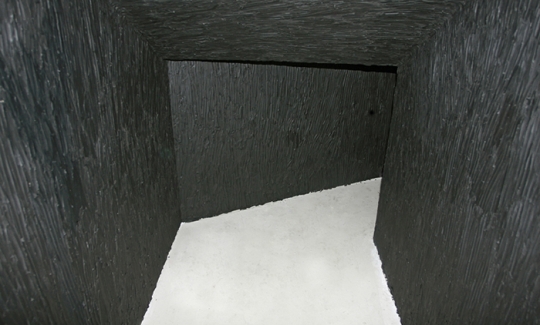Curator: Tal Yahas
In Sever's installations, the viewer's presence in space constitutes one of the fundamental elements responsible for charging the work with meaning. The spaces she creates are constructed on a scale incompatible with the human body; they also involve intentional disruptions, such as elements that block the viewer's gaze and restrict his movements.
Despite their large size and absurd quality, these works are characterized by a significant degree of restraint and calm stemming from a use of simple geometric forms, a lack of ornamentation and a restricted palette. Most of these works belong to one of two main groups: white works and black works, which may at times reveal the wooden or metallic surface of one of the objects integrated into them. The walls of the white works (such as Untitled, 2007, which was included in the Haifa Museum of Art exhibition "Passing the Batonette: Four Decades of Feminism in Israeli Art") are composed of white plaster or plywood; they function as architectural extensions that have no purpose other than overtaking the space in which they are located.
The black works - such as Black Hole, which is featured in the current exhibition - stand out in greater contrast to the white exhibition spaces. This dissonance is given expression not only in terms of their color but also in terms of their surfaces, which resemble an active material - a kind of teeming epidermis with a dark, vital quality. The walls of the current installation have been covered with black plasteline. This plastic material, which is associated with childhood and innocence, blocks the corridor-like space it creates and transforms it into a threatening, nightmarish site. The plasteline's organic texture, which preserves the memory of the hands that kneaded and acted upon the material, alludes to the possibility of reading this space as a natural form, such as a cave or a womb. The black, angular space, with its sloping ceiling and neon lighting, may also trigger vague memories of the staircase leading down into a bomb shelter. Yet in the absence of a descending set of stairs to parallel the sloping ceiling, this space seems to increasingly suffocate the viewer; it is transformed from a shelter and hiding place into a mysterious, ominous space.

